
If you are investing time, effort, and money to train your employees, it’s reasonable to design a proper method to track the program’s effectiveness accurately. That’s what pre and post tests do.
As of 2022, businesses spend over $1,200 and 62 hours per employee on training. So it makes sense to monitor the ROI of the exercise.
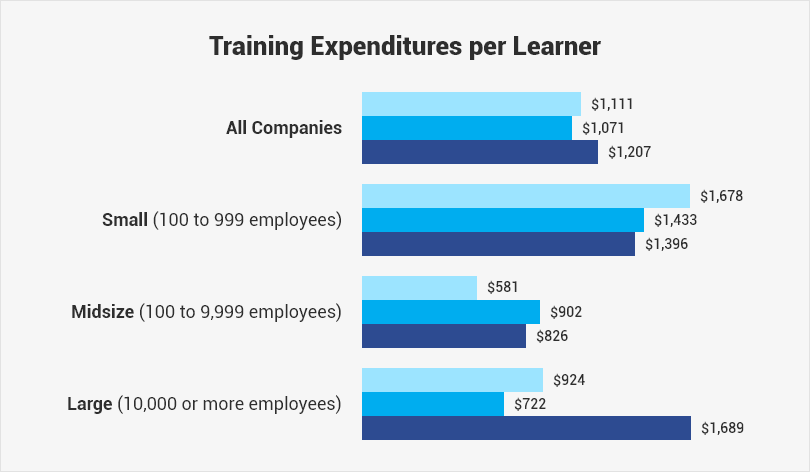
But training modules always have a post-evaluation test. So why is there a need for a pretest-post test assessment design?
Because it lets you track the progress against a benchmark to make data-backed decisions. And when it comes to students, pretest-post test assessments become more crucial to track the current knowledge level of each student and the understanding and progress they have attained after a course or lesson.
This blogpost will help you get started on pre and post-tests.
We will guide you through the entire process of creating some of the best tests to assess your learners. We have also added a list of pre and post-training assessment questions so you can create quizzes quickly.
So, sit back and keep reading!
What is Pre & Post Testing?
Pretest and post-test is a targeted methodology to assess learners during a program or study. The participants can be students, test subjects, employees, medical personnel, or a sample focus group.
The method is used in research, classrooms, and control studies to test the participants’ knowledge, skills, critical thinking ability, and disposition before and after a program.
The pretest helps set a baseline for each participant and group. The progress is then measured against these initial scores. The post-test provides the data that reflects the changes in the initial scores to assess the study’s success.
Pretest-Post Test Design: Definition & Examples
Pretest-post test design research is used in quasi-experimental and experimental studies to evaluate the candidates before and after administering a study or treatment.
Here’s the simplest example of a pretest and post-test design:
Suppose a research study needs to test the effectiveness of after-school programs on students’ grades. This quasi-experimental study selects the control groups of students from two different schools. One group attends the after-school program, while the other does not.
A pretest assessment would measure the grades for both groups before the start of the program. A post-test is taken after several weeks when the program concludes to gauge the program’s impact on the grades.
Another example is an employee training program using the pretest-post test design to test the knowledge before and after the training.
Watch: What Is Employee Training?
Difference between pretesting and post testing
As mentioned above, pretesting is conducted before the commencement of a program, training, or study to measure participants’ current level of knowledge.
Along with this, it can help make changes or improvements to the program according to the pretest results.
A post test, on the other hand, is run to see the program’s results or the impact of learning on participants and measure its success.
What are Training Assessment Tests?
Training assessment is a process of identifying the level of skill, knowledge, and competency in a candidate before and after a training program and then comparing it against a benchmark.
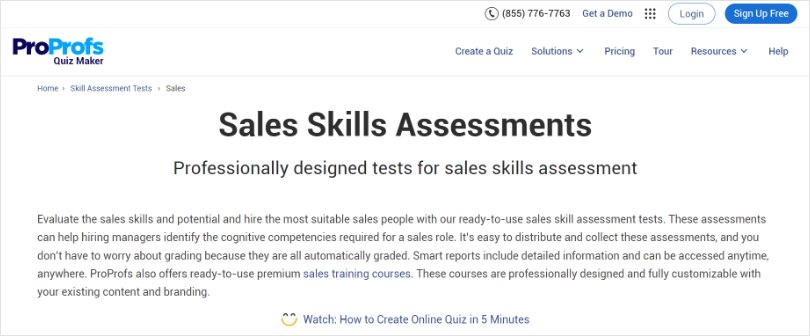
It is an effective way of dealing with any competency gaps because it helps identify the difference and uncovers training needs.
Based on the time you conduct it, a training assessment test can be of two types:
Pre-Training Assessment Test
A pre-training test is administered either at the very start of training or before the training begins. Pre-tests are given to learners before the instructions are presented to screen out participants that are not the right fit for the training.
Such tests aim at identifying the level of knowledge and skills of the individuals to help trainers prepare the training modules depending on who needs more training and attention.
All trainees share a common goal: to develop more knowledge and learn new skills to put into practice whenever necessary.
A pre-training test can help trainers develop modules that will guide progress and improvement by meeting the needs and expectations of the learners.
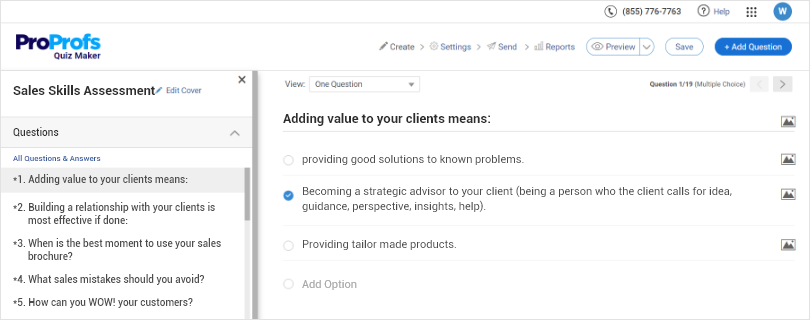
Some examples of pre-training assessments are as follows:
- Sales Video Interview
- Spanish Proficiency Assessment
- English Proficiency Assessment
- Communication Skills Assessment
- Carl Jung’s 16 Personality Type Assessment
Post-Training Assessment Test
Unlike the pre-training assessments, post-training assessment tests are administered at the very end of a training program.
You should always present a training evaluation report at the end of every training module to let trainers know how well the trainees absorbed the information and the overall training effectiveness.
Post-training tests also provide tons of other valuable insights into the training programs from the perspective of the participants, which is essential in uncovering what works and what doesn’t.
Trainers can evaluate the data collected from the post-training assessments and better understand improvement areas in the training modules and the candidates who require more attention.
Some examples of post-training assessments are as follows:
- Post Training SaaS Quiz
- Seasonality Post Training Quiz
- ECAP Product Training
To create practical training assessments, you will need an online assessment tools like ProProfs Quiz Maker that can effectively cater to all your assessment needs in an instant. It offers over 100+ ready-to-use templates and a resourceful question bank to help you create assessments instantly.
It even features an automatic grading and reporting system to help you analyze the data and track the performance of individual candidates without any extra effort.
Watch: How to Choose the Best Assessment Software
Related Read- If you would like to explore more about different types of assessments, take a look at 7 Different Types of Assessments You Should Know About
Why do pre and post-assessment tests matter?
Here are a few reasons that make a case for why a pretest and post test design should figure in your training assessments:
Establish baseline
One of the most essential aspects of the pretest-post test assessment is the ability to set a measurement baseline. Whether you are administering an online course for students or corporate training, you can evaluate the knowledge gaps and trace the path for the course that maximizes the output at the end, which can be measured by post-tests.
Controlling the confounding variables
Suppose you are conducting a training program for your sales team to enhance their core skills. You can run the pretest to evaluate the current skill level and establish indirect or confounding variables that may affect the training outcome. It would help to produce reliable results that accurately measure the program’s effectiveness on the employee’s knowledge.
Identify gaps in knowledge
If you are designing a course for students, a pretest can help you assess individual students. For example, you can identify the weak and strong students. The results can help teachers make changes to the curriculum to consider these students. It provides an equal opportunity for all the students to progress through the class without being overwhelmed.
Track the efficacy of the program & intervention
Pretest-post test assessments can help you make data-based decisions. Let’s take another example. Suppose you run an employee training program and take a post-test assessment.
- How would you know that the results reflect the progress or that the employees were already aware of the course topics?
- How would you make the changes to improve the training program?
- Which portions of the program need improvements?
That’s where the pretest comes in handy. You can design a pretest that assesses the participants on different topics. Then, use a post test to see how much knowledge they could absorb and make modifications to the sections with the lowest progress.
Now that you have understood training assessment tests, let’s take a look at when to perform these tests.
When to Perform Training Assessment Test
You can conduct assessments at any possible time.
Still, in most cases, they are only conducted during the onboarding process, performance evaluation, career development, or structural changes within the organization.
Even though assessments do not have a specified time frame, it is best to conduct them periodically to determine training needs and the program’s effectiveness.
It’s even better to specify scenarios in which the assessments will be conducted.
Here are the four best options for nailing the timing of your assessment tests:
1. Before Training
Conducting assessments before training is extremely important because it allows trainers to ensure that the participants can easily fulfill the prerequisites and perform well in training.
The next step will be to create a pre-training test that will evaluate the learners on all the necessary criteria.
Many experts suggest that the best time to create your assessments is right after you have established the learning objectives but before creating your training modules.
It may seem a little counterintuitive but creating assessments after setting your objectives saves you from running the risk of going off-target with your assessments.
But before you create your assessments, here are some points that you should consider:
- The kind of test items you need to create
- Number of test items to include in your assessments
- Passing score of your assessments
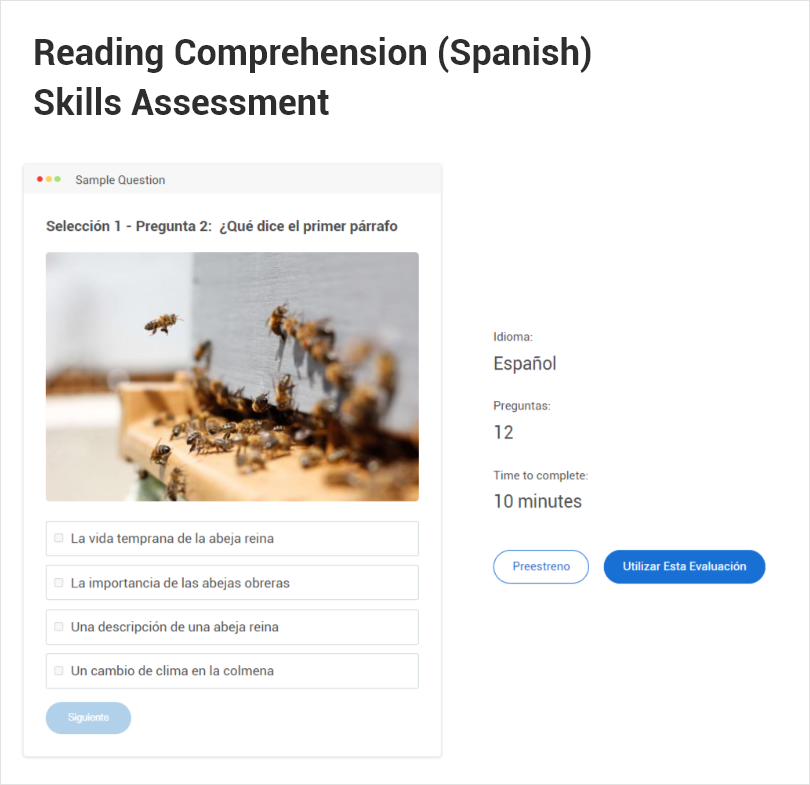
For instance: the Reading Comprehension (Spanish) Skills Assessment is an ideal pre-training test to check the Spanish proficiency that may be required in the final assessment.
2. During Training
Conducting assessments during training is a great idea if you aim to provide practice and receive feedback from the participants simultaneously.
Trainers can judge the effectiveness of the tests depending on how satisfied the learners are with them.
There are tons of ways in which you can improve the overall quality of your training modules, and receiving feedback from the test takers is one of those ways.
But that’s not all.
Conducting assessments during training also allows trainers to provide feedback to their learners, which creates an amazing learning opportunity.
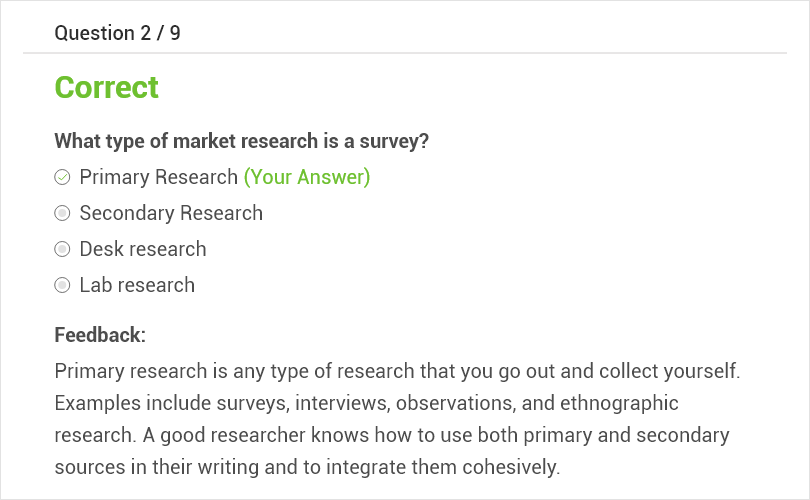
All you have to do is to make sure that your assessment tests create an avenue for instant feedback to ensure maximum impact.
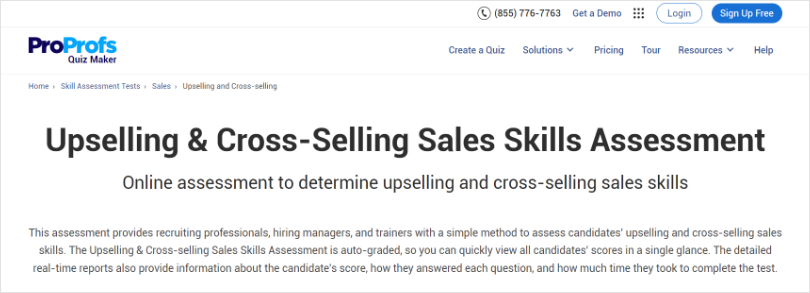
For instance: Upselling and Cross-Selling Sales Skills Assessment can be used during the sales training to see how well the test-takers are absorbing the specific information.
Related Read- Learn more about the benefits of employee feedback with our blog: Improve Work Environment Using Employee Feedback
3. Right After Training
Assessing learners through tests right after the training is one of the most popular ways of assessment. It helps trainers know if the learners have met the learning objectives.
An ideal training test should always be valid and reliable in terms of the questions to yield accurate results.
Valid tests are always accurate, which means if a learner passes the test, they satisfy the learning objectives and vice versa.
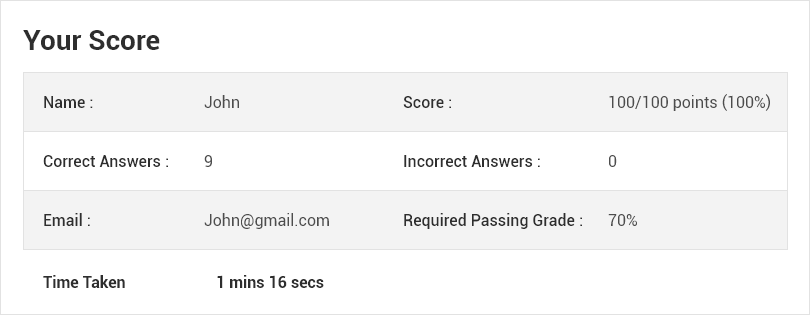
Reliable tests, on the other hand, give consistent results. Even if a learner does not meet the objectives, a reliable test should always tell that.
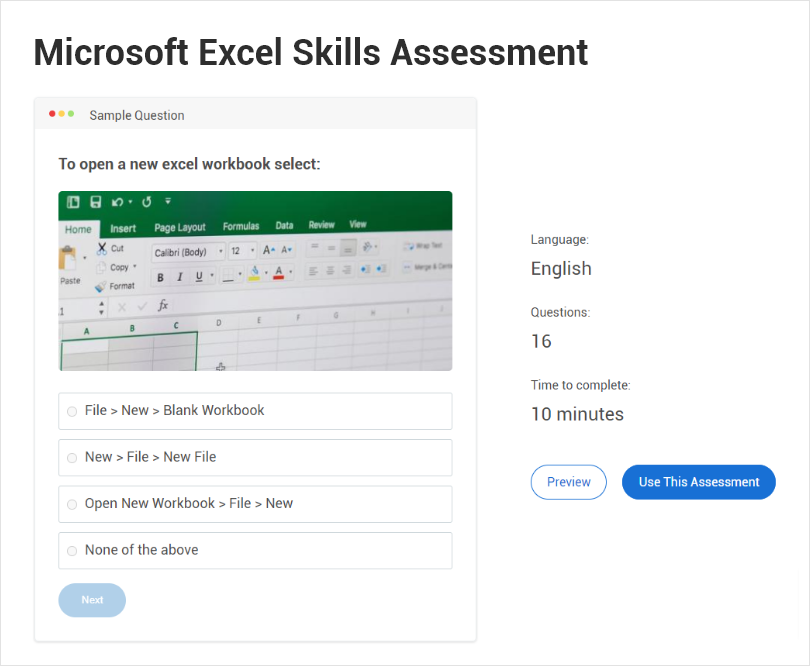
For instance: a Microsoft Excel Skills Assessment test can be used right after the Excel training to gauge the overall understanding of the employees and the effectiveness of the training module.
4. A While After Training
It is always beneficial to create tests and assess employees once they have been on the job for a while. This is because as time passes, employees tend to forget things that they have learned in the past.
Post-training tests prove to be great in refreshing the memory of the employees and improving short-term recall.
For instance: the Bookkeeping Skills Assessment test can be used a while after the bookkeeping training to check how much information has been retained by the employees post-training.
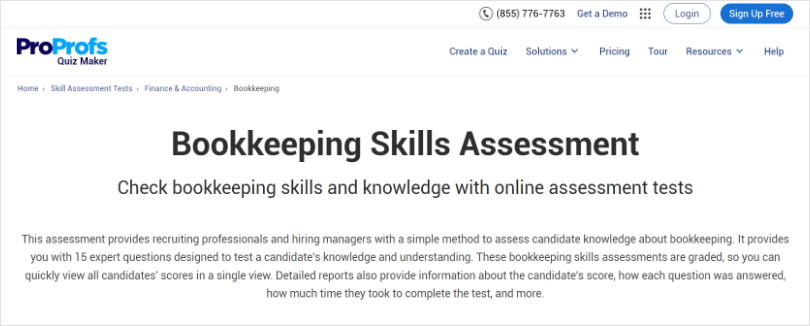
You also need to define the outcomes that will follow after your employees take these tests. For instance: passing the tests would mean the employees can go to the next activity or continue with their job as normal.
Failing the test would mean that employees will either have to retake the test or go through the training again based on their performance.
Make sure to keep the possible outcomes moderate and communicate them effectively to have all your employees on the same page and provide a great learning curve.
After reading this, you will surely be able to nail the timing of your training assessment. Now let’s explore some of the best practices for creating impeccable assessments.
Best Practices to Create Training Assessments
When it comes to the best practices for creating amazing training assessments and gauging employee performance, an often overlooked area is making corporate training assessments fit the training design.
To shed some light on the issue, here are some of the best practices to create amazing training assessments:
Personalize the Assessments
Personalizing learning paths is something that has almost no downsides. This is the reason why a number of companies deploy adaptive learning to present a range of content and learning activities as a part of employee training.
Assessments are one of the best ways to deploy this level of personalization.
As a trainer, you should analyze the knowledge of the employees and take into account the level of difficulty of the assessment tests and their previous exposure to the content and topics.
Doing this will let you create and select the best assessments.
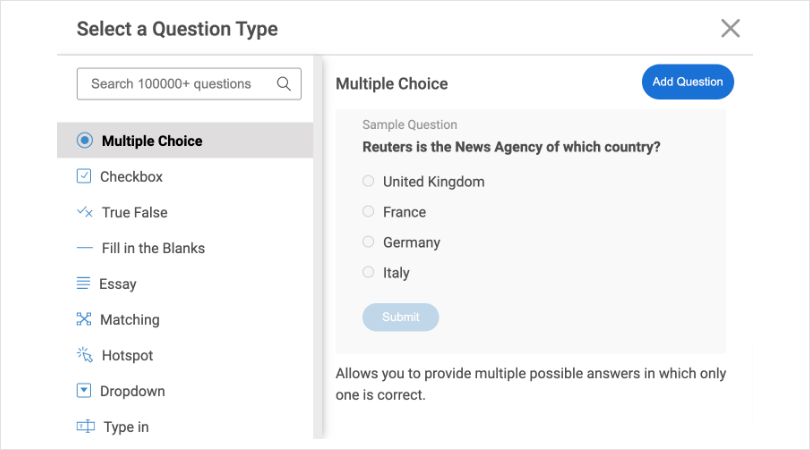
Also, don’t be stingy when it comes to variety. Provide a range of different question types in your quizzes and assessments.
Be Clear and Concise
Training assessments should always be clear and aligned with the objectives of the training program. This will make the assessments more effective and fetch accurate training data.
You should always ensure that your questions and instructions are clear and concise to avoid any room for misinterpretation.
Long sentences often frustrate the test takers and can sometimes be misunderstood. This is why it is necessary to ensure that your questions are crisp and properly worded.
In short, your training assessments should:
- Be clear and aligned with the objectives of the training program.
- Leave no scope for misinterpretation for maximum efficiency.
- Be brief and appropriately worded.
Watch:How to Create an Assessment Online
Use Feedback to Make Improvements
An extremely clever way of creating amazing assessments and making improvements is by using feedback from the participants of the previous assessments.
You can significantly improve the success rate of your training program by making necessary changes to the assessment structure, questions, and other important elements by knowing what worked well and what didn’t.
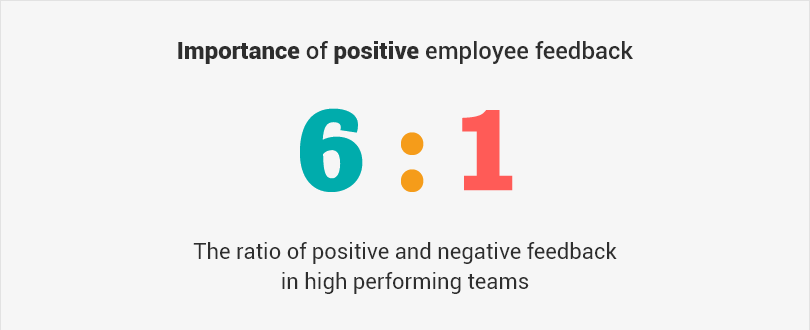
In addition, analyzing previous feedback will encourage you to keep improving the quality of your assessments by knowing which methods to deploy and which ones to avoid.
Avoiding the same mistakes and using tools that the participants welcome will help you build training assessments that are truly effective and impactful.
Final Assessment Review
At this point, your assessments are created, but they are not quite ready yet.
There is a high possibility that some minor or even major errors could seep in during the creation process. This is why a final review is necessary to catch any such mistakes and eliminate them before the full-scale deployment.
You can do this either on your own or with the help of a subject-matter expert, who will carefully assess the objectives and the delivery of the assessments.
Here are a few things to look out for:
- The learning objectives should always fall in line with the assessments.
- Make sure that you got the number of test items correct.
- Include test items that measure workplace performance, difficulty, and other important criteria.
Beta Test
You’ll be quite tempted to share the assessment with your employees once you’ve created them, but ideally, you shouldn’t.
Before your assessments are sent out to test learners’ knowledge, it is best to do some trial runs with a select group of people.
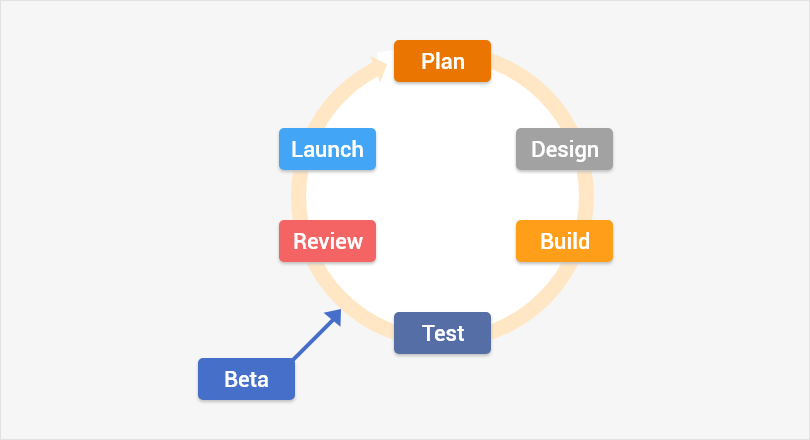
Once you’ve reviewed your tests yourself, gather a target audience and carry out beta testing to gauge the effectiveness of the tests. Here are some points to consider while you do so:
- Conduct beta testing in the same environment as you would do in real testing.
- Make sure that your target audience represents your real audience to some extent for higher accuracy.
- Carefully spot problems and confusion from the beta test audience and try to identify any set patterns.
- Look for problems in the checklist or rating scales from an evaluator’s perspective.
Now that you know how to create assessments in the best possible way, it all comes down to the evaluation. Let’s take a look at the different ways of evaluating assessments.
Related Read- To learn some more best practices for creating online assessments, take a look at 10 Best Practices For Remote Training.
How to Evaluate Your Training Assessments
Creating training assessments is just 50% of the work. The other half involves evaluating those assessments and identifying if they are perfectly aligned with the training goals and objectives.
There are plenty of ways of assessing training assessments. Here are some of the most effective ones:
1. The Kirkpatrick Taxonomy Model
The Kirkpatrick Taxonomy model is arguably one of the most widely used methods to measure the effectiveness of corporate training programs.
Don Kirkpatrick developed this model, and it is a comprehensive four-level strategy aimed at evaluating training programs.
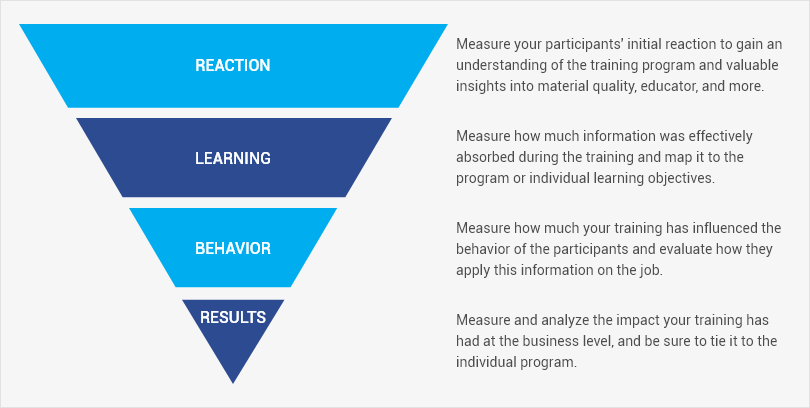
The four levels of this model are as follows:
Level 1- Reaction
As the name suggests, this is where the trainers will observe how the participants react to the training programs given to them. Here, the trainers can give a feedback form to the participants to determine if the conditions for learning were present in the training program and what they thought about it.
Level 2- Learning
The second stage of the model aims at understanding what the participants have learned from the training program. Here, giving short quizzes and practical tests before and after the training are the best way of doing that.
You can use an online assessment creator tool and create specific tests to gauge your participants’ knowledge before and after the training. For example, you can create a Workplace Safety Skills Assessment test to evaluate your employees before and after conducting workplace safety training.
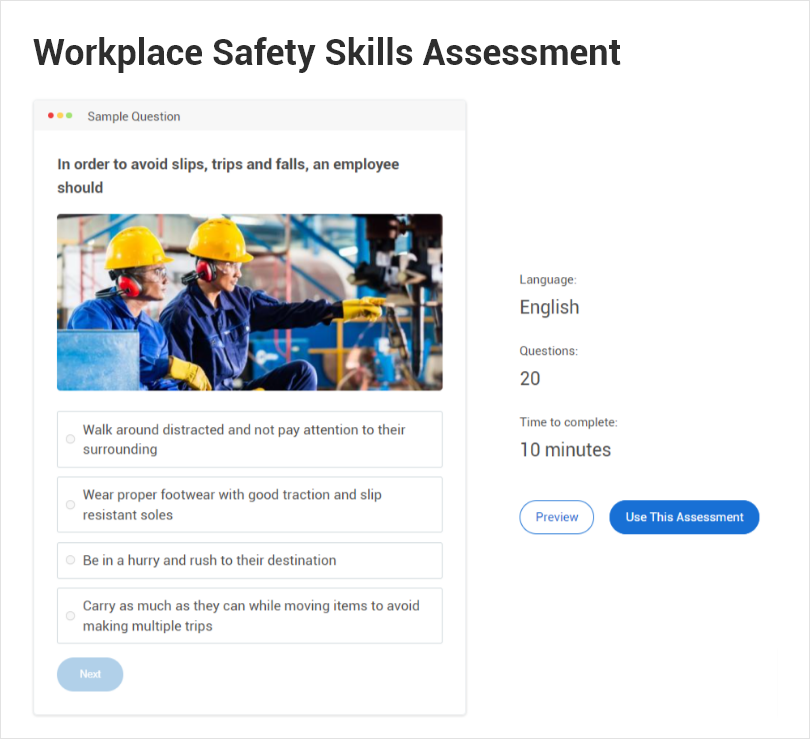
Level 3- Behavior
This stage comes a while after the training program. Here, your job is to assess the participants based on what they learned during training by putting them on the job. You will be observing whether there’s any measurable change in their behavior following the training. Trainers can let participants fill up a self-assessment or ask their supervisors to do the same.
Level 4- Result
The final step is to analyze if the training was able to meet the stakeholders’ expectations, which is done by calculating the Return On Expectation (ROE).
2.The Phillips ROI Model
This method is very closely related to the Kirkpatrick Taxonomy Model, but it involves an extra step of calculating the Return On Investment (ROI), which is done by measuring the total difference between the cost incurred during training and the final training results.
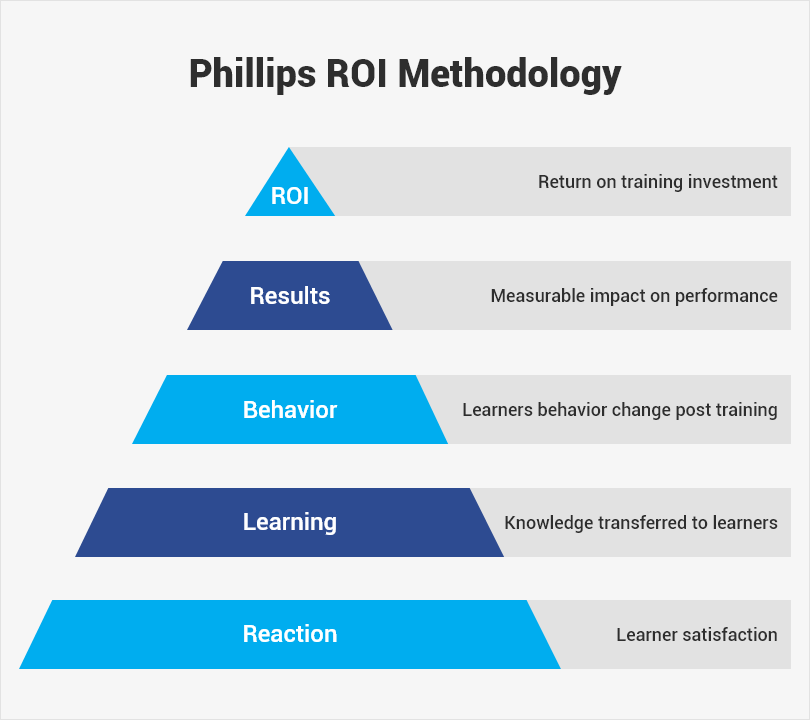
These are the steps that the Phillips ROI Model follows:
Step 1- Collect the pre-training data
The first step is to collect pre-training data to get the baseline, set a benchmark, and for the final comparison of scores before and after the training.
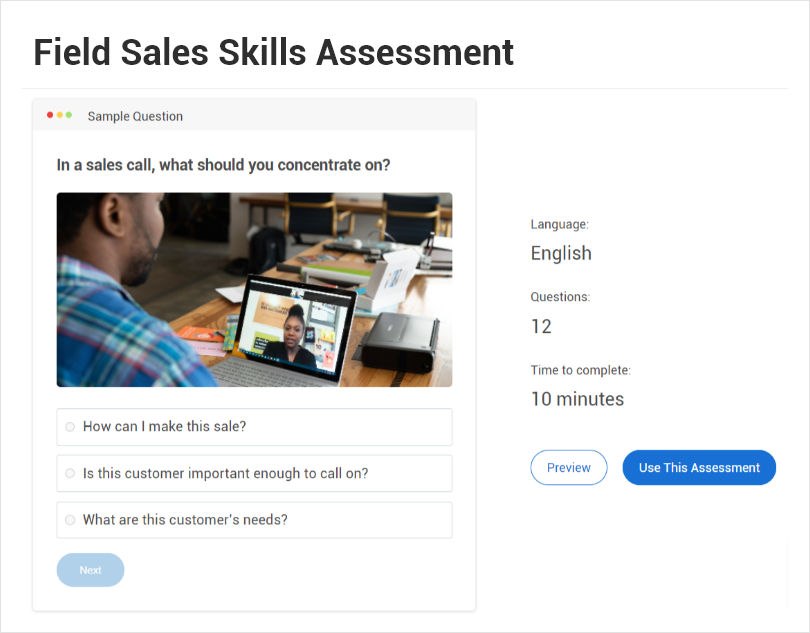
Here, you can deliver a pre-training assessment identical to the training module to identify the learners’ level of understanding. For example, those working in the field sales role can be given the Field Sales Skills Assessment before training to create a baseline using their understanding of the subject.
Step 2- Collecting the post-training data
The second step involves collecting the data after the training from a number of different sources like participants, peer groups, supervisors, and other internal and external sources.
You can even gather data through automated reports if you conduct tests using ProProfs Quiz Maker.
Step 3- Isolate the effects of the training program
This stage involves identifying if the certain outcome was the result of the training program. All the key elements that contributed to the outcome are identified here.
Step 4- Convert the data into monetary gains
Once the effects of the training program have been isolated, you need to convert the data into monetary values to uncover the overall program cost.
Step 5- Calculate the total return
The final step is to calculate the returns from the training program. If the training results exceed the cost, it is an indication of a positive ROI. If the training results do not exceed the cost, trainers need to modify the programs.
3. Summative and Formative Evaluation
A thorough evaluation through summative and formative assessments can uncover crucial insights about the drawbacks of your training programs. While formative evaluation helps you assess training programs during the development stages, summative evaluation will help you assess the effectiveness of the training after it has been implemented.
First, let’s look at different ways to conduct formative evaluation:
- Conducting individual or group reviews with peers.
- Using training material in real-life situations to gauge the test’s effectiveness.
- Asking managers and supervisors for their feedback and expert opinions.
- Conducting group discussions or brainstorming sessions with a group of other trainees.
Now, let’s look at different ways of conducting summative evaluation:
- Conducting post-training tests to gauge the grasped information from the training sessions.
- Asking feedback from the participants once they have taken part in the training.
- Asking post-training survey questions with the trainers to get an evaluator’s perspective.
- Measuring changes in the quality and quantity of work performed after the training.
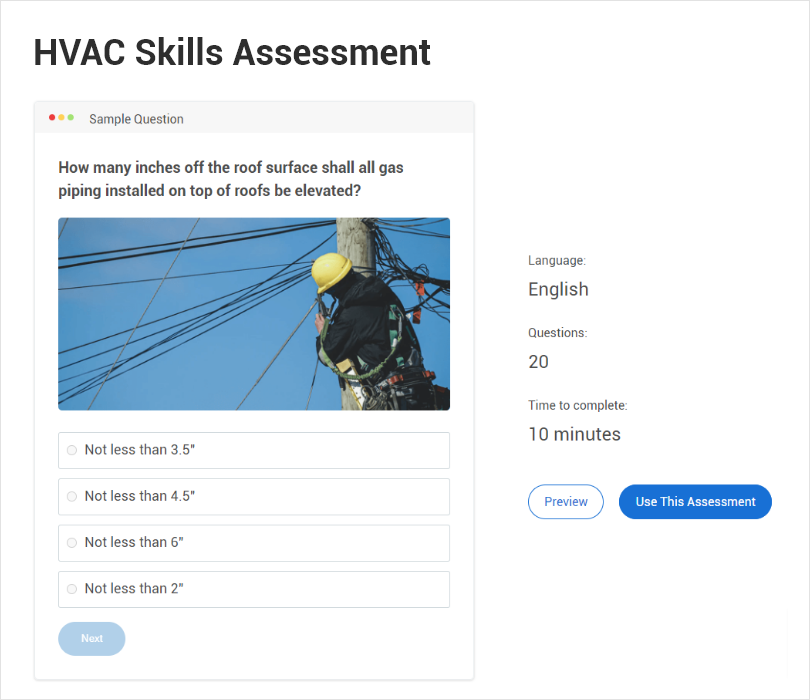
HVAC Skills Assessment is a great example of summative assessment that can be conducted after the HVAC training.
4. Kaufman’s Five Levels of Evaluation
Kaufman’s Five Levels of Evaluation is another popular way of assessing training programs. It also builds itself on the foundation laid by the Kirkpatrick Taxonomy Model.
As the name suggests, it involves five different levels of evaluation that are as follows:
Level 1- Input
Input involves all the resources and the learning material that trainers use to impart knowledge and skills through the training programs.
Level 2- Process
As the name suggests, this involves all the steps that are involved in the delivery and the acceptance of the learning experience through training programs.
The assessments used to evaluate the training will also be considered as one of the elements.
Level 3- Micro level results
This step involves considering if the candidates were able to successfully acquire the knowledge and skills required for their respective jobs.
Level 4- Macro level results
This step involves evaluating any performance improvements that have taken place and the different benefits that learners received from the training programs.
Level 5- Mega level impact
The final level involves assessing the benefits that the training can have on a much larger scale, like the society or the external stakeholders.
5. Anderson’s Model of Learning Evaluation
Anderson’s Model of Learning Evaluation is another effective way of evaluating training assessments that helps businesses prioritize their long-term business strategies.
There are three different steps to this strategy. They are as follows:
Step 1- Evaluation
It involves evaluating the current training programs against the business’s strategic priorities.
Step 2- Calculation
This step involves calculating the training programs’ contributions towards the business strategies.
Step 3- Selection
The final step involves selecting the right approach for the business by choosing a training program and calculating the ROI.
Benefits of a Pre and Post-Assessment Test
There are several ways pre and post-tests can benefit users. Here are some of them:
1. Identify Training Needs
New employees always go through training when they are first hired, but workplace learning never stops.
Whenever new strategies are implemented or new systems are introduced, employees are likely to need additional instructions and get used to the new changes.
This is where pre and post-assessment tests can prove to be helpful.
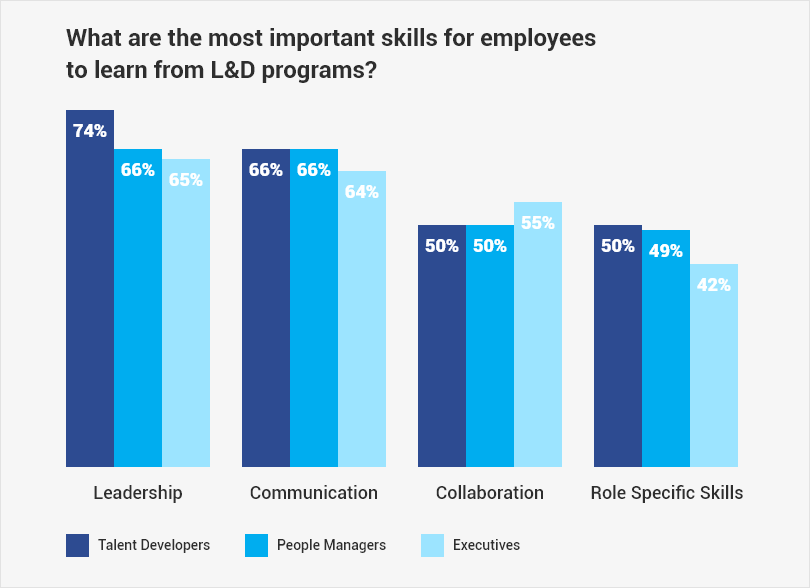
2. Improve Overall Performance
The most obvious benefit of pre & post-testing is improving the overall performance of employees.
Taking time to conduct pre & post-testing and then analyzing the results helps trainers compare the results and identify problems and the areas that need further attention.
As a trainer, you can identify improvement areas and then develop and modify training modules accordingly to cover those specific areas.

Later, you can conduct post-training tests to see if the employees are now able to achieve their benchmark.
Providing constructive feedback after the training and post-training tests are also essential in helping employees perform better.
Identify Improvement Areas
Pre and post-assessment tests can be used to evaluate the employees before and after training and compare the results side-by-side to monitor improvements.
Here, areas that have not seen much improvement even after the training can be singled out and focused specifically to help employees perform better.
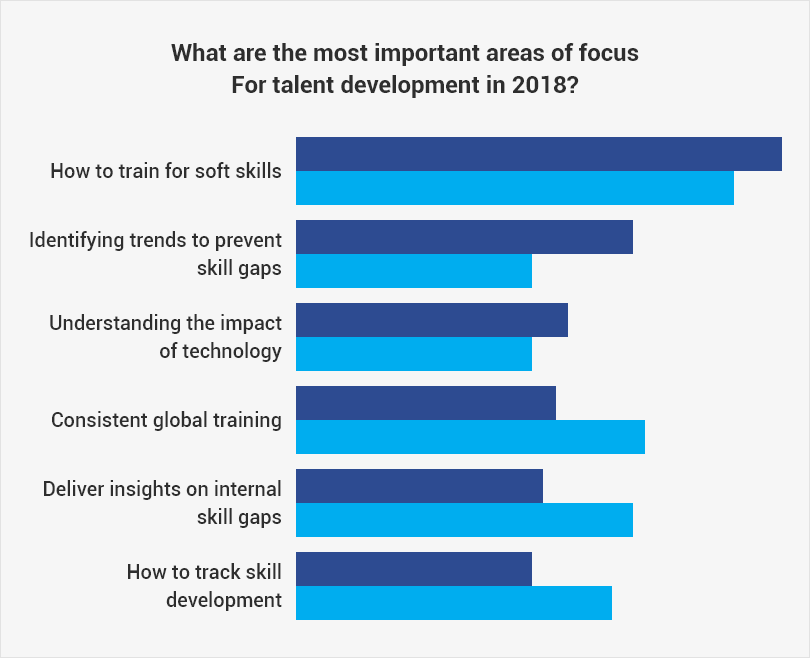
Pre and post-tests also help trainers spot any trends and patterns relating to the low performance by a number of employees in specific areas.
These areas can be traced back to the training modules, and improvements can be made to help employees learn and perform better.
Trainers can also provide suggestions and expert opinions, which the employees can use to perform better.
Better ROI
Another huge advantage of conducting pre and post-test is the return on investment gained from the process.
Pre & post-testing the employees on a regular basis helps them learn more and grow within the organization. According to a study, 94% of employees who experience growth are likely to stay with the organization for longer.

Retaining employees is much more economical than hiring new ones, and there are no two ways about it.
Conducting pre and post-tests also makes the output measurable, and being data-driven is something that every organization aspires to be.
When employees and managers deal with real numbers, it becomes much simpler to identify the current and desired position based on organizational goals. Managers can then put in the required efforts to maximize output and eventually the ROI.
Related Read- Explore some more benefits of online assessment with Benefits of Using Online Assessments
Case Studies
Here are some real-life examples of companies that are trailblazing employee performance and pre and post-training evaluations.
Accenture
Contrary to popular belief, large companies with thousands of employees can easily assess all their employees and overhaul their training processes.
Accenture, the giant tech consulting firm, with over 300,000 employees worldwide, is a classic example. They were able to completely ditch annual reviews and humanize their performance management system with the help of pre and post-tests.

The result was more timely feedback from managers and employees, and even the compensation process was more equitable for all company employees.
“We’ll eliminate the traditional closed-door rating meeting where we talk ABOUT people. Instead, we’ll talk WITH people in frequent coaching conversations.” – Ellyn Shook, Chief Leadership and Human Resources Officer, Accenture.
Acer
Acer is one of the biggest IT companies in the world, with a presence in over 160 countries. Employees at Acer are dedicated to research, design, marketing, sales, and solutions to close the gap between people and technology.
With a huge product lineup and over 7,000+ employees, Acer wanted a solution that would help them train and certify their employees on new product releases. They wanted a powerful quiz and assessment tool, which the users can use to request training courses wherever needed.

This is why they deployed ProProfs Quiz Maker to simplify & organize their training process and receive support and customizations that they needed. Using this, Acer created a training system that includes online training, assessment, and certification programs for the new product releases.
Facebook has always been one of the best places to work for any employee.
Of course, their fun and interactive work environment, along with great employee compensation and perks, are the key to that, but there are a lot of other elements that contribute to this success.
Like many other companies of the same size, Facebook conducts semi-annual assessment tests followed by peer-to-peer and employee-to-manager feedback.
By zeroing in on the standardized assessments and peer feedback, managers at Facebook get an accurate understanding of how employees perform and collaborate.
Also, using the internal software, managers and employees at Facebook are able to give and receive feedback at any time, even during the assessment period, which saves them from getting caught off-guard.
Now that we have covered almost all the important aspects of pre-training and post-training assessments, let’s finally take a look at what questions you can ask in your pre and post-training assessment tests.
Quiz Questions for Your Pre and Post-Training Assessment Tests
You could ask innumerable questions before and after the training assessments depending on your training type and topic.
Here are some examples:
Pre-Training Assessment Quiz Questions
- What are your learning objectives for this course?
- What topics would you prefer learning during the training?
- How confident are you about the course content?
- How do you believe this course can help you improve your previous learning?
- What are the biggest barriers to learning that you have been experiencing?
- What is your preferred learning style?
- What do you wish to achieve at the end of this course?
- What areas of the topic do you struggle the most with?
- Have you taken any training courses in the same field before?
- What are your motivations for this training program?
Post-Training Assessment Quiz Questions
- Were you satisfied with the quality of the course offered?
- Did you like the certificate offered at the end of the course?
- Do you feel that you were able to achieve your learning objectives?
- Was the course able to meet your expectations?
- What did you like the most about this training course?
- Do you feel that your skills have improved after the training?
- Are you satisfied with the opportunities provided during the training?
- Were your needs met after completing the training?
- How would you like to rate the guidance received during the training?
- Would you prefer receiving the training material in print?
Related Read- To learn more about some of the most effective training survey questions, have a look at 20+ Best Online Training Survey Questions.
The quiz questions, however, are only as effective as the tool you pair them with.
This is where an online quiz maker proves its worth. ProProfs Quiz Maker is one such tool that caters to all pre and post-training assessment test creation needs. It offers 100+ ready-to-use test templates and 1000,000+ ready-to-use questions to help build powerful quizzes and assessments.
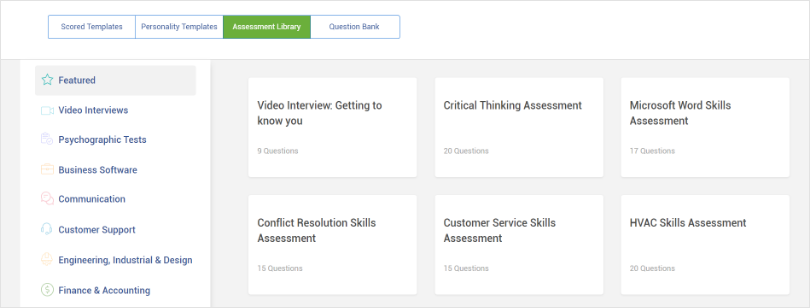
With ProProfs, tracking individual and group performance is a breeze as it offers downloadable and shareable score summary reports, quiz takers’ answer reports, and time taken per question reports. These reports help quiz takers in training evaluation, tracking, and compliance.
The tool also features built-in automatic grading and scoring system, which makes assessing quiz takers easy and quick. It also opens a two-way communication street to send and receive actionable feedback for every pre and post-training assessment.
Integrating the tool with survey maker software or poll maker can help you get insightful feedback from the learners to improve the course material, delivery and more.
Also, the best part is that it integrates with other online training tools to take training functionalities to the next level.

For example, you can integrate it with an online training maker tool like ProProfs Training Maker and its top-of-the-line LMS Software to make training and assessments effectively work for learners.
With it, you can easily create multiple virtual classrooms and train learners anytime and anywhere. The tool also offers tons of built-in training templates with over 100+ customizations to help you create custom training courses for any scenario or use case.
You also get auto-generated training reports at the end of every course, which will help you track the performance of every learner or group and monitor improvements. With its Learning Record Store, you can centralize your data, record interactions, and analyze learning experiences easily.
Evaluate Learning With a Right Mix of Tests
Evaluating learning is a critical part of every training program.
It not only tells you what learners thought of the course but more importantly, it uncovers the impact it had on the learning process.
In addition to that, using a competent assessment maker is an important prerequisite too.
Now that you know all the details about evaluating learning, it’s your turn to make some incredible pre and post-training assessment modules to educate your learners.
So choose the right tool and begin your testing and assessment journey!
FAQs
Do pretests and post tests need to be the same?
Typically, the measured variables in pretests and post tests are the same. However, the questions are different to track the progress and effectiveness of the program.
What is the main purpose of pretest and post test assessments?
Pretests and post tests measure learners’ understanding, retention, and growth. They help establish what learners already know and still need to learn.
How do I conduct pre and post-tests?
Here are the steps to conduct pre-test and post-tests:
- Set pre-test objectives and compile the quiz questions
- Conduct the pre-test
- Score and evaluate the results
- Implement the curriculum/training
- Conduct a post-test
- Analyze and interpret the results
- Compare pre and post tests
FREE. All Features. FOREVER!
Try our Forever FREE account with all premium features!





